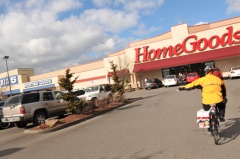
in suburbia can happen.
(Photo © J. Maus)
It’s a somewhat generally accepted concept in urban planning circles that there’s no hope for suburbia. Cinder block walls, cul-de-sacs, and wide arterials all make for a car-centric lifestyle. But new reseach shows that among suburban multifamily housing — the fastest growing housing type in the U.S. — biking and walking can thrive.
In Overlooked Density: Re-Thinking Transportation Options in Suburbia, Nico Larco, an assistant professor of architecture at the University of Oregon, focuses on suburban multifamily housing, which he calls a “widespread and overlooked example of density.”
“Dispelling commonly held beliefs about the amount of walking and biking occurring in suburbia, our study shows that more than a third of all trips to the LCA [local commercial area]… are active travel trips.”
His findings show that, not surprisingly, site design and connectivity to commercial areas are major factors in whether or not residents choose to walk or bike. Among developments in the study that were well-connected to commercial areas, more than 44% of residents choose to walk or bike to them — a rate that’s nearly twice as high as multifamily developments that lack connectivity.
But what is surprising is that, contrary to our popular perception of suburbia, “Across all studied developments, more than a third of all trips to nearby commercial strips are taken on foot, with a total of 38.7 percent taken on foot or by bicycle.”

Larco writes that there may be, “additional latent active transport in suburbia,” but it will only be realized if developers and planners make connectivity and “pass through” between their units and commercial areas a top priority. For those that get it right, here’s what they have to look forward to (taken from chapter 2 of the study):
“The latent potential in proximity of residences and commercial areas can reduce residents’ reliance on automobiles and increase active modes of travel such as walking and biking, especially for short trips under a half mile. Increasing active travel might reduce vehicle miles traveled, which has positive impacts on the environment as it reduces carbon emissions. In addition, walking and biking can have a positive effect on residents’ physical and mental health and can provide economic savings.”
Especially significant in Larco’s field of study are the health, economics, and equity implications. As he notes in the study, the typical demographic of suburban multifamily housing includes the elderly and lower-income individuals. “Increasing active travel for these populations,” Larco writes, “can have an economic effect as residents do not need to have access to automobiles or pay for additional fuel for these short trips.”
Larco’s study was funded by the Oregon Transportation Research and Education Consortium (OTREC). Learn more and download the final report at the OTREC website.

